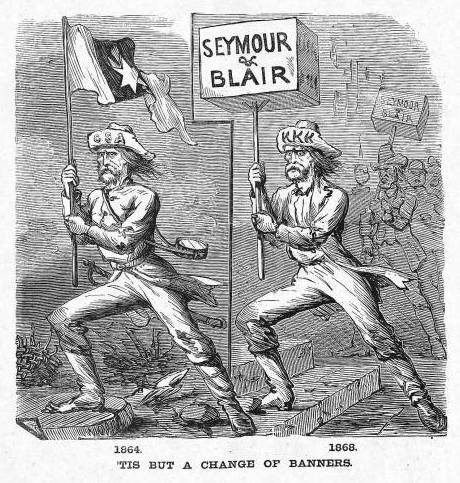“Racism, Revolution, Reaction 1861-1877” is a Marxist and Trotskyist analysis of the rise and fall of Radical Reconstruction. The book was originally published in 1976 by Pathfinder Press. The author, Peter Camejo, was the presidential candidate for the Socialist Workers Party the same year. He later left the SWP, and was Ralph Nader's running mate in 2004. Camejo's book is still distributed by the SWP, however, and could be regarded as the party's official statement on Reconstruction.
The author's main point is that the Northern bourgeoisie only reluctantly
supported the Reconstruction in the South. The Radicals within the Republican
Party were a tool to secure the control of the Republican machine over the
Southern states, and indirectly the federal Congress and the White House. In
order to accomplish this goal, Blacks had to be given the right to vote and
equality before the law. Thus, the Republicans had to confront, sometimes
violently, the Democrats, the party of White supremacy. However, the Northern
industrialists and bankers didn't allow the reforms to go too far. For
instance, no real land reform (“40 acres and a mule”) was implemented in the
Southern states. Blacks remained, for the most part, a pool of cheap labor.
Through a complicated process, described in the book, the Radicals were
gradually undermined and eventually lost power to the Conservatives or
Democrats, who “redeemed” the Southern states, disenfranchised Blacks and
eventually implemented full-scale segregation in the form of Jim Crow laws.
This was all done with the full complicity of the Northern political
establishment, most clearly visible during the so-called Compromise of 1877,
when the Southern Democrats supported “Half-Breed” Republican Rutherford B
Hayes for the presidency, in return for full “home rule” in the South.
Camejo uses the Trotskyist term “Thermidor” to describe the victory of
Conservative counter-revolution in the South. Used in this way, “Thermidor”
implies a change of political regime from revolutionary to
counter-revolutionary, but without a change in the economic relations. The
South was capitalist both during Reconstruction and after. The old slave power
wasn't restored. The significance of this is discussed further below. (The
curious term “Thermidor” comes from the French revolutionary calendar. The
Jacobins were overthrown by more moderate forces during the month of Thermidor
in 1794.) It's interesting to note that many leading figures in the Radical
administrations survived the “redemption” by simply changing sides, re-emerging
as Conservatives and Democrats. It's both interesting and dismaying to note the
large number of White abolitionists who betrayed their ideals (and the Blacks!)
in favor of a “compromise” with the Southern racists. It's also dismaying to
note that the Radicals, and the Republican machine in general, really were
super-corrupted. It's tragic that African-Americans became dependent on one of
the most corrupt administrations in U.S. history as allies, and very uncertain
allies at that. Thaddeus Stevens was one of the few Radicals who never betrayed
his principles, and attempted to push for a land reform in the South. Stevens
died already in 1868, however.
Camejo's main point is that the ex-slaveholders didn't return to power in the
South following the fall of Reconstruction. The Compromise of 1877 wasn't a
deal between the Northern bourgeoisie and a Southern class of ex-slaveholders.
Rather, the power of the slaveholders had been completely broken during the
Civil War. The Southern economy became completely dominated by Northern
interests, primarily financial and railroad interests. This was true during
*both* Radical Reconstruction and the Conservative reaction. People associated
with the Old South, such as ex-Confederate generals, were used as figureheads
by the Northern interests, but they weren't in command, neither financially nor
politically. The poor Whites were (of course) mobilized under the symbols of
the old racist slavocracy, but they were tools used by the industrial
capitalists to secure their domination of the South. Thus, the Compromise of
1877 was really a backroom deal between two wings of the same class, the
Northern bourgeoisie (represented by presidential-hopeful Hayes) and a
“Southern” bourgeoisie economically integrated into the North's orbit
(represented by the Southern Democrats). Since most Southern states had already
been “redeemed”, the real point of the compromise was the Southern demand for
more federal subsidies to infrastructure, a promise which Hayes later broke.
The Populist movement in the South represents a crack in the White racist
alliance, when poor White farmers realized that they had been manipulated by
the Conservative-Democrat leaders.
Camejo's point about the ex-slavocracy not being in charge isn't strictly
academic, of course. He wants to prove Trotsky's theory of permanent
revolution, and connect it with Marx' call for a “revolution in permanence”.
One of his targets is the Communist Party, which called on Blacks during the
civil rights era to support the “progressive” wing of the political
establishment (the Northern liberals) against the “reactionary” wing (the
Southern conservatives). By depicting the Southern racist establishment as a
holdover from the slavocracy, the Communist Party could claim that the
bourgeoisie (identified with the Northern liberals) still had a progressive
side, since it at least opposed the most reactionary forces in American
society. It could be pressured into abandoning the Compromise of 1877. If, on
the other hand, the slavocracy was effectively dead by 1865, and Radical
Reconstruction was smashed by the same bourgeoisie that held the reigns of
power in the North, the political conclusion becomes socialist revolution
against *all* factions of the bourgeoisie, North and South. The more concrete
conclusion is: no reliance on liberals in the White House, Blacks must organize
independently. (The SWP supported the creation of an independent Black
political party.)
The above is an attempted summary of a more complex analysis, but this is the
gist of it. Regardless of what you may think of the author's political
conclusions, “Racism, Revolution, Reaction” is sufficiently interesting to be
recommended reading for everyone studying this particular period in U.S.
history. It's also surprisingly easy to read.

No comments:
Post a Comment